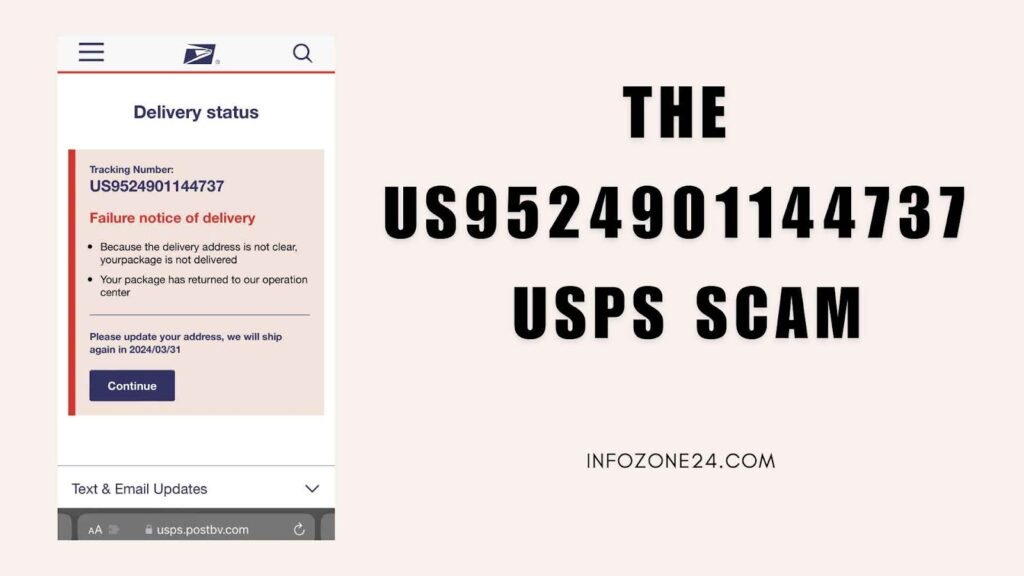A new scam posing as the United States Postal Service is targeting Americans through emails and text messages claiming a missed package delivery. The scam uses a fake USPS tracking number – US9524901144737 – to seem legitimate. Recipients are urged to click a link to resolve the delivery issue.
Instead of a genuine USPS site, the link leads to a deceptive website designed to steal personal and financial details. Scammers then sell this information online or use it for identity theft and fraud. This widespread scam has already harmed numerous victims across the country.
In this article, we’ll explore how the US9524901144737 USPS scam operates. We’ll dissect the initial scam message and examine the intricacies of the counterfeit USPS website. Lastly, we’ll provide advice on what to do if you’ve been targeted by this fraudulent scheme.
Join us as we uncover why this scam has been so effective in deceiving people and causing substantial financial losses.
Is US9524901144737 a Real USPS Tracking Number?
No, “US9524901144737” is not a real USPS tracking number. It is a fake tracking number often used in phishing scams to deceive recipients into believing there is a genuine package delivery issue that requires their immediate attention. It’s a SCAM!
How Does The US9524901144737 USPS Scam Work?
The US9524901144737 USPS scam employs urgency, credibility, and technical deception to manipulate recipients into giving their personal information.
Let’s walk through each phase of this scam:
Stage 1: Initial Contact
Victims receive what appears to be a legitimate message from USPS, often through text, email, or voicemail. Scammers use technology to spoof official USPS contact information, making the initial message seem trustworthy.
Recipients typically see a message like:
“USPS Alert: A package addressed to you was returned due to an incomplete address. Click here to verify your address for redelivery: [malicious link]”
The urgency conveyed in these messages, coupled with a tracking number (e.g., US9524901144737) that resembles authentic USPS tracking numbers, convinces many recipients to click the link without suspicion.
Stage 2: Redirect to Fake USPS Site
Clicking the link redirects victims away from the official USPS website to a meticulously crafted phishing site. This fake website replicates USPS’s official design, logos, and content to an uncanny degree, aiming to deceive even savvy internet users.
The URL of the fake site may resemble USPS’s legitimate domain with slight variations, such as USPS-secure365.com or USPS-service.com.
Upon arrival, victims encounter the fake tracking details prominently displaying the US9524901144737 tracking number.
Alongside, a message reads:
“Tracking Number: US9524901144737
Copy Add to Informed Delivery
Delivery failed, addressee unknown
Your item was delivered at 12:11 pm on February 10, 2024, in [your location]. But the delivery guy couldn’t find you at the shipping address.”
This detailed fabrication further convinces victims that a legitimate package intended for them has encountered delivery issues, reinforcing the urgency to resolve the problem.
Stage 3: Request for Personal Information
The phishing site prompts victims to input personal information to “reschedule delivery” or “update address details.” The site’s layout mimics USPS’s authentic website, featuring identical fonts, colors, logos, and navigation menus.
What details do the scammers ask for? Victims are asked to provide:
- Your full name
- Phone number
- Street address
- City
- State
- ZIP code
In some instances, the site may also request credit card information under the pretext of a small redelivery fee (e.g., $0.50). Unsuspecting victims who comply unknowingly surrender their personal data, including sensitive financial details.
Stage 4: Exploitation of Stolen Data
So, what do the scammers do with your information? Once victims submit their information, scammers immediately gain access to valuable personal data. This information can be sold on the dark web for high profits or used directly for malicious activities, including:
- Selling personal details to other cybercriminals
- Committing identity theft to open fraudulent accounts or file fake tax returns
- Initiating extortion attempts by threatening to expose victims’ personal information unless a ransom is paid
- Targeting victims with future phishing attempts tailored to their personal details
The repercussions of falling victim to the US9524901144737 USPS scam are severe, often resulting in financial losses, compromised personal security, and prolonged efforts to rectify the damage.
How to Spot the US9524901144737 USPS Scam?
What are signs this is a scam? Well, identifying and avoiding the “US9524901144737 USPS Scam” involves recognizing several crucial indicators.
It’ll be an Unexpected Package Alert
If you receive a delivery failure notice for a package you weren’t expecting or didn’t order, approach it with caution. Scammers exploit this tactic to catch recipients off guard.
There’ll be Generic Greetings
Phishing emails and texts often use impersonal greetings like “Dear customer” instead of addressing you by name. Legitimate USPS communications typically personalize their messages with your name.
It’ll Sound Urgent
Scam messages create urgency, pressuring you to act quickly to resolve a supposed delivery issue. They aim to provoke impulsive clicks on links without careful consideration.
There’ll be Suspicious Links
Check the links in the message. Scammers redirect to unfamiliar websites that mimic USPS but have URLs with slight variations from the official “USPS.com.”
Sender’s Address is Strange
Emails from scammers may come from non-official addresses that don’t end in “@USPS.gov” or a recognized USPS domain. Be cautious if the sender’s address seems unfamiliar or suspicious.
Requests for Personal Information
Be wary of any request to enter sensitive personal data online to address a delivery problem. Legitimate USPS communications do not ask for such information via unsolicited messages.
Poor Grammar/Spelling
Phishing attempts often contain spelling errors, typos, or awkward language usage. Official USPS communications are typically well-written and free of such mistakes.
There’ll be Follow-up Scams
After an initial phishing attempt, scammers may continue to contact you, either through more emails or phone calls, to pressure you into providing personal information.
By staying alert to these signs and verifying any suspicious communication directly through USPS’s official channels, you can protect yourself from falling victim to the “US9524901144737 USPS Scam” and similar phishing schemes targeting personal information and financial details.
What to Do If You Have Already Entered Your Personal Information?
If you have entered personal information in response to a suspicious message related to the “US9524901144737 USPS Scam” or any similar phishing attempt, take these immediate steps to protect yourself:
1. Cease Further Interaction
Stop any further communication with the sender or website immediately. Close the browser tab or app where you entered your information.
2. Monitor Accounts
Regularly monitor your bank accounts, credit card statements, and any online accounts for unauthorized transactions or activities.
3. Change Passwords
If you entered login credentials or passwords, change them immediately for any accounts that may have been compromised. Use strong, unique passwords for each account.
4. Report to USPS
Forward the suspicious email or text message to USPS at spam@uspis.gov. Reporting helps USPS investigate and take action against phishing attempts.
5. Place Fraud Alerts
Consider placing a fraud alert on your credit report with one of the three major credit bureaus (Equifax, Experian, TransUnion) to protect against identity theft.
6. Contact Financial Institutions
If you entered financial information like credit card numbers, contact your bank or credit card issuer immediately. They can monitor your accounts for suspicious activity and may issue a new card if necessary.
7. Enable Two-Factor Authentication
Enable two-factor authentication (2FA) on your accounts wherever possible for an added layer of security.
8. Educate Yourself
Learn more about common phishing tactics and how to recognize them to avoid future scams.
Taking these steps promptly can help minimize the potential damage from phishing scams and protect your personal and financial information. If you notice any unusual activity or suspect your identity has been compromised, consider seeking further guidance from identity theft resources or legal professionals.
Frequently Asked Questions (FAQs)
What should I do if I receive a suspicious message related to the US9524901144737 USPS Scam?
Do not click on any links or provide personal information. Instead, verify the communication directly through the official USPS website by typing the URL (www.usps.com) into your browser. Report suspicious emails or texts to USPS at spam@uspis.gov and delete them immediately.
Are there variations of the US9524901144737 USPS Scam?
Scammers involved in the USPS phishing scam may use various fictitious tracking numbers similar to “US9524901144737” to deceive recipients. Some variants commonly observed in similar scams include:
- US3425345123456
- US8765432123456
- US9876543212345
- US1111222233334
- US5555666677778
These tracking numbers are designed to appear legitimate to unsuspecting individuals receiving fraudulent messages.
Where can I report the US9524901144737 USPS Scam or similar phishing attempts?
Forward suspicious emails or texts to USPS at spam@uspis.gov. You can also report phishing attempts to the Federal Trade Commission (FTC) through their official website or contact your local postal inspector.
How can I avoid the US9524901144737 USPS scam?
To avoid the US9524901144737 USPS Scam:
- Check all messages claiming to be from USPS for signs of phishing. Visit USPS’s official website directly instead of clicking links.
- Contact USPS using verified phone numbers from their website, not those provided in suspicious messages.
- Do not click on links in emails or texts that lead to unfamiliar websites or differ from USPS.com.
- Refrain from entering personal information on sites accessed through suspicious links or messages.
Conclusion
So, don’t fall for the US9524901144737 USPS package scam. This scam shows how phishing tactics are becoming more sophisticated. By impersonating USPS and creating convincing fake websites, scammers exploit urgency to trick people into sharing personal information.
Recognizing the scam’s steps—from the initial contact to fake tracking details—helps protect against falling victim. Verify USPS communications directly, avoid clicking on suspicious links, and protect personal information to reduce the risk of identity theft and financial harm.
Staying vigilant and following these precautions are essential in combating this widespread digital fraud.


